3 Preps, Cues, and Releases
Frances Fonza
Learning Objectives
In this chapter, students will:
- identify the necessary components of preparatory gestures (preps), cues, and releases
- conduct clear and effective preps, cues, and releases
- identify within musical contexts where to apply preps, cues, and releases
 One of the most ubiquitous communal music making experience we have today is singing Happy Birthday. Consider for a moment how this usually starts (especially among non-musicians!):
One of the most ubiquitous communal music making experience we have today is singing Happy Birthday. Consider for a moment how this usually starts (especially among non-musicians!):
- One bold member of the community breathes (somewhat) loudly and begins singing, while the rest haphazardly join in
- A person carrying a cake starts singing “Haaaaaa” as they walk into the room attempting to keep the candles lit while eventually the rest of the community joins in
- Perhaps an ambitious person counts “1, 2, 3!” and then the groups breathes together and starts singing on a variety of starting pitches.
What might you do differently than the options listed above to help your community more beautifully celebrate a birthday? (And what’s wrong with counting to 3?)
The conductor has a vital role in managing the sound of the ensemble. Through careful attention to detail the conductor teaches the ensemble when to come in and when to stop singing or playing. This includes entrances, releases and everything in between. It is important that the conductor become well-versed in how to get the ensemble to stop and start together. There are three areas in which a conductor should be proficient to successfully lead an ensemble: preps, cues, and releases.
Hand Independence
A factor that will assist in prepping, cueing, and releasing is independence of hands. Mirroring is a great method to use on occasion, but when the hands are free to express time, tempo, dynamics, cues, releases, emotion, and all that the music offers, there is a wonderful interplay between the director, ensemble and the music. Novice conductors should do exercises that build hand independence. This will lead to freedom in the hands so that one hand can beat time while the other is able to cue or release.
Hand Independence Exercises
Exercise:
- Pretend to throw a dart with one hand while using the other hand to wave to a friend.
- Practice conducting a 4-pattern in the dominant hand while making clockwise circles with the other hand. (Also try using counterclockwise motion).
- Practice a 4-pattern in the dominant hand while moving your left hand up and down in a crescendo – decrescendo gesture. The non-dominant hand will start with the palm up at waist level and raise to approximately sternum height, then turn palm down and return to the starting point.
- Practice a 4-pattern in the dominant hand while moving the non-dominant hand left to right or right to left in a sustain gesture (carry a tie across the barline, for example)
Preps:
In conducting, the preparatory gesture sets the tempo, dynamics, and style of the musical ideas that follow, allowing the singers or players to identify how they should perform the proceeding measures. There are several elements involved in a good preparatory gesture. Eye contact and breath are two of the most important. Strong eye gaze directed toward ensemble members will make them aware of when to come in. Eye contact is helpful even before the hand gesture is initiated, indicating to ensemble members that it is almost their turn. Right before the beat in which the ensemble should sing or play, the conductor should breathe with the singers/players to indicate that it is time for them to come in. Essentially, the ensemble members should be breathing with you. The hand gesture on the prep is also quite important as it signals the preparation before singing or playing. The prep gesture typically comes the beat or half a beat before the entrance of the singers/players. It can occur on any beat, so it is important that the gesture aligns with the beat that is being prepped. For example, if the choir sings on beat 3, the preparatory hand gesture would come on beat 2. If the band plays on beat 4, the prep gesture would come on beat 3. A bit trickier, if the group performs on the “and of 2,” the prep gesture would likely come on 2.
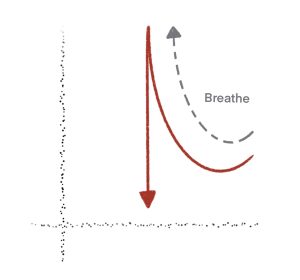
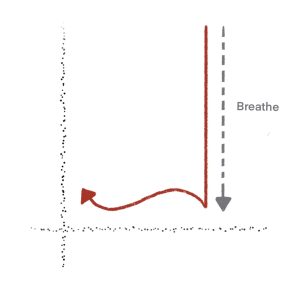
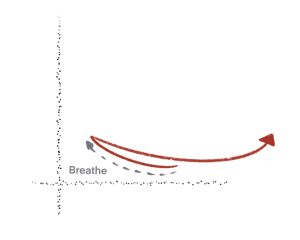
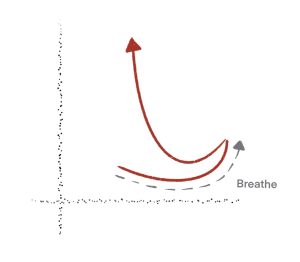
Finally, the prep must also include the tempo and expressive qualities of what is to come. The prep must be in tempo to ensure unity from the ensemble. Keep your hand still and maintain eye contact while audiating (singing in your head) a full measure before you move your hand for the prep.
Prep Exercises
- In a mirror, practice the prep for each beat, ensuring that eye contact and breath are incorporated
- Practice prepping each section of the ensemble (soprano, alto, violins, trumpets, etc)
- Practice the prep using various tempo markings (adagio, moderato, allegro) – be sure to make eye contact and breathe the tempo you desire
Cues:
Cues save lives! The Conductor has a hand in helping the ensemble come in together successfully. This is done by cueing. Cueing allows the ensemble to know exactly when to come in. It’s vital that the conductor knows and understands the score thoroughly so they can lead the ensemble with clear cues. Cues can happen with the hands, head, eyes, mouth, and other body gestures. A good conductor is sensitive to the needs of the ensemble and learns which cues their group needs to be successful. In instrumental settings where the players do not see a full score, only their individual part, cueing is especially important as the individual players do not know where they fit into the whole. Conversely, choir members regularly see all of the parts and know when they come in with respect to other sections.
There are three parts to a cue. The prep, the actual cue, and the “thank you.” For the prep, the conductor should look at the section (eye contact) in which they want to cue, before the time of cueing, and breathe before the beat in which the group should come in (this allows the group to breathe at the proper place before coming in). The cue includes a hand motion that represents the style, dynamic, and tempo of the subsequent music. Cues can be given with either the time-keeping hand or the expressive hand. If given with the time-keeping hand, the cue should be anomalistic; take it out of the pattern in some way. This is most often accomplished by raising the height of the ictus for the cue, as can be seen below.
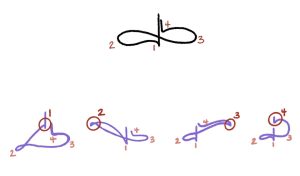
If the right hand is keeping time, the left hand can cue with the palm facing up or down. The “thank you” is simply giving acknowledgement (feedback) that you are glad the group came in at the right time. This feedback is nonverbal. A quick smile, head nod, or thumbs up will suffice. When the conductor must provide cues to multiple sections in succession, this feedback may not be given because of lack of time. Still, this three-step combination (prep, cue, “thank you”) should be used when possible, as it is a great way to get the groups to come in at the right time and feel good about the work they’ve done.
Cue Exercises




- Put section names on the wall in front of you, (SATB etc) and practice cueing the sections on beat 4, then on beat 3, etc. Be sure to make eye contact, breathe before their entrance, and give feedback once they have come in correctly.

- Practice giving cues on successive beats at various tempi
Releases:
The release happens at the end of a phrase, word, or end of the song. Ideally the ensemble will stop and start together, and the conductor has a hand in helping the group stop at the same time. Releases can happen on any beat, sometimes fast or slow, and even loud or soft. The conductor identifies, through score study, the appropriate release, and needs to prepare the ensemble to end together.
To achieve a good release, the conductor should make eye contact with the ensemble and use the hands to release the sound by tapping above the point of rebound, with the hand. This can be done using one hand or both hands. Another way in which to achieve a release is to simultaneously circle the right hand counterclockwise and the left hand clock wise and then stop the movement when the sound should stop. Note: This author does not recommend a closed fist for releases, as it can have a negative effect on the sound at the release, espeicially in a choir, where voices tend to mimic the motion of the release affecting intonation or tension.
Release Exercises
- Using a 4 pattern, practice stopping the group on each beat, starting with beat 4.

- Using a 4 pattern, practice releasing various sections of the ensemble (sopranos, altos, tenors, and basses)

- Gather a group of friends and have them sustain a neutral syllable. Practice cutting them off on various beats.
Stop Gestures
Releases that happen internally, or within a phrase, often are demonstrated with a stop gesture. Stop gestures function exactly as implied – there is a pause in movement at the point of the ictus before moving into the next beat, and the rebound is essentially eliminated. That hold at the point of the ictus reliably communicates both the timing of the beat and that something unusual is happening, typically a lift or pause in phrasing. Musical elements where stop gestures may be appropriate include phrase marks, quick rests, articulation markings, and punctuation marks in text. The images below demonstrate patterns with stop gestures.
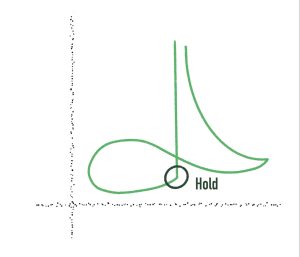
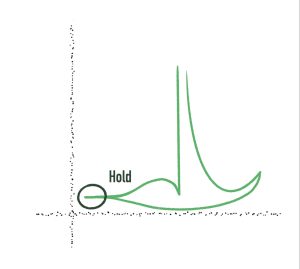
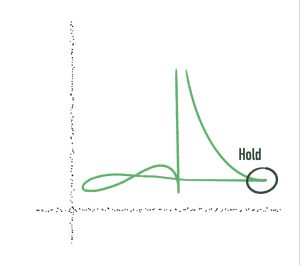

Facial Expression
Another important component to the Prep, Cue, and Release that is often overlooked is facial expression. It is important that the face of the conductor reflects the intent of the music. This should also be expressed as one cues and releases the ensemble. If the music is sad, the facial expression of the conductor and subsequently the ensemble should be sad (with the necessary vocal space needed to sing well). Facial expression should also be required of the performers, to better express and interpret the text and emotion behind the music properly.
Facial Affect Exercises
- Videotape yourself cueing a small group of friends, with each of the following facial expressions (happy, sad, angry, nervous)
- Watch yourself in the mirror as you pretend to cut off an ensemble using facial expressions (happy, sad, angry, nervous)
Preps, Cues, Releases and Hand Independence Competency Check
With your teacher, demonstrate efficacy on the exercises throughout this chapter:
- Cue Exercise (Teacher will choose one line for competency check)
- Include appropriate prep gestures before all cues
- Release Gestures
- Facial Affect
- Hand Independence
Preps, Cues, and Releases Final Reflection
In your ensemble, pay attention to your conductor’s use of preps, cues, releases, and hand independence. When starting or stopping doesn’t go well, how does the conductor adjust their communication (verbally or non-verbally) to achieve greater success? When starting or stopping has been successful, what did you notice about the conductor that contributed to that success?

